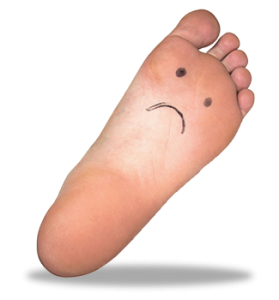
Foot Pain and Caring for Your Feet by Darren Naito
 Seventy-five percent of Americans will experience foot pain. The human foot contains 26 bones, 133 joints, 107 ligaments, and 19 muscles, so there are many parts to care for to prevent injury. Stretching, proper shoes, massaging, and a healthy diet (if diabetic) are all ways to help keep your foot in good condition.
Seventy-five percent of Americans will experience foot pain. The human foot contains 26 bones, 133 joints, 107 ligaments, and 19 muscles, so there are many parts to care for to prevent injury. Stretching, proper shoes, massaging, and a healthy diet (if diabetic) are all ways to help keep your foot in good condition.
Stretching can be easily done at home using simple items such as a bath towel or golf ball. Sit on the floor with your legs straight out in front of you. Roll the towel and wrap it around your toes and pull lightly and hold for thirty seconds and repeat for three sets. Next, take the golf ball and roll it back and forth from your heels to your toes. Next find a curb or step and stand with your toes on the step with heels off the edge. Lower your heels down slowly and hold for ten to fifteen seconds, then lift back to starting position. Repeat five to ten times, this works great with people living with planter fasciitis.
Here are some tips to help with finding the right shoe:
- Choose a shoe that conforms to the natural shape of your foot. Make sure the ball of your foot fits into the widest part of the shoe.
- Try not to wear shoes that have higher than a 2 1/4’’ heel. This can cause bunions and calluses.
- When purchasing new shoes, you might want to try on both shoes, since one foot is sometimes larger than the other.
- Don’t always rely on shoe size, try on the shoes since sizes vary among brands.
- Have each foot measured regularly, feet tend to change in shape and size with age.
Massaging your feet can improve circulation and relieve pain and discomfort. Place your foot between your hands, with your fingers facing forwards. Rub your hands backwards and forwards along your foot, creating warmth. Place one thumb on top of the other, using your fingers to support your foot, and make circular thumb pressures over the sole of your foot. Stroke the area and then repeat the sequence. For toes, with one hand, stretch your toes back gently. Use you other hand with an open palm and gently tap the sole of your foot. This will stimulate blood circulation.
If you’re a d iabetic, it is very important to care for your feet. The feeling in your feet can slowly start to go away when you have diabetes. If you can’t feel your feet, you take the chance of missing foreign objects making their way into the sock or shoe. You can form blisters, which can lead to open sores and cuts. Check your feet each evening when you take off your shoes. For people suffering from diabetes, a bad shoe day can be very threatening. Wearing the wrong kind of shoes can lead to serious problems, and sometimes can be so serious that amputation becomes an option. Wearing therapeutic shoes helps to minimize the risk of skin ulcers and breakdown for diabetics.
iabetic, it is very important to care for your feet. The feeling in your feet can slowly start to go away when you have diabetes. If you can’t feel your feet, you take the chance of missing foreign objects making their way into the sock or shoe. You can form blisters, which can lead to open sores and cuts. Check your feet each evening when you take off your shoes. For people suffering from diabetes, a bad shoe day can be very threatening. Wearing the wrong kind of shoes can lead to serious problems, and sometimes can be so serious that amputation becomes an option. Wearing therapeutic shoes helps to minimize the risk of skin ulcers and breakdown for diabetics.
Sources:
Toyourhealth.com
Ewellnessmag.com
niddk.nih.gov/health-information/diabetes/preventing-diabetes-problems/keep-feet-healthy/take-care-your-feet-lifetime
drspjohnsondc.wordpress.com/2010/10/25/why-are-your-feet-so-important
The information provided is for general interest only and should not be misconstrued as a diagnosis, prognosis or treatment recommendation. This information does not in any way constitute the practice of medicine, or any other health care profession. Readers are directed to consult their health care provider regarding their specific health situation. Marque Medical is not liable for any action taken by a reader based upon this information.
